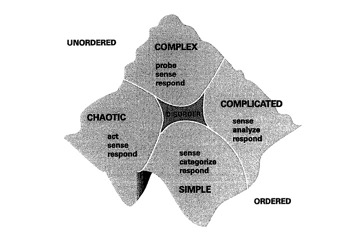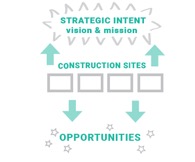From Predict & Control to Sense & Respond
Everything will unfold with more grace if we stop trying to control and instead choose to simply sense and respond. (Frederic Laloux, Reinventing Organisations)

Strategy Work needs to strike a delicate balance: It needs to navigate between the dangers of merely drifting with the environment and of overplanning in a delusion of control. The concept of “Sense and Respond”, last re-introduced to the Organisation Development discourse by Frederic Laloux, describes a mode of development between the two. It is neither fully comprehensive nor free of contradictions but it sure has the ring of a timely title for a new era.
Peripheral Vision
In the Sense & Respond Mode we are seeking resonance to internal and external dynamics that are just being born. We are grasping a future, which exists only as a seed or fragile sprout in the here and now. This kind of sensing into the world is all but trivial: we tend to deselect anything that is new and unfitting. Alternatively, we interpret it though the filters of our perception to conform to our mental models. When I read the paper, chances are that I focus on and remember those things that fit my world view. Whatever is unfitting will evade my attention and get drowned out. In strategic processes “Weak Signals” that flicker as messengers of big developments in the noise of the world, equally fall prey to these filters of perception. We have to actively seek them out – particularly at the edges of our field of vision.
We can support this search by cultivating our networks as dispersed sensing surfaces – a strengthening of the organisation’s “peripheral vision”. In order to do a good job at this, our network needs to be informed what kind of signals we are interested in. Cognitive filters can be countered by systematic contrasting of perspectives from different people. Another option is to meet the signals with open intuition – as Otto Scharmer describes in his Presencing approach.
The Sensing does not only relate to signals from the outside world but equally to the internal environment, to the awareness for impulses and developments within the organisation. Where are new ideas and directions of development coming about? Where are meaningful insights and discoveries being made? What are potentials for focussing attention (oh most precious resource of our time)? The ability to sense and respond to these dynamics requires a certain amount of “Jazz competence”. Listening, comping (the musical short for respectful harmonic accompaniment of a soloist), and setting impulses – all make for a fruitful emergent development and are far from given. Laloux’s concept of the evolutionary purpose describes how on the grounds of such mindful interaction the Bigger Picture of the strategic lines emerges in a collaborative process. Structurally it requires the permission, for people in any position to take strategic decisions on the ground. Planning and implementation are not distinct processes here, but interwoven. Sensemaking happens in motion.
Just as with the Open Space approach I am wondering: is that still strategic? And if not, is that bad? Hasn’t the discovery of mindfulness opened a post-strategic era that is quite all right to live in?
When an organisation asks me to consult them in a strategy process, my first question back to them is, why they believe they need a strategy in the first place. Often this question effects a mix of a raised eyebrow and a shrugged shoulder. You simply need a strategy, period. Oh yeah? If strategy is indeed only a “pattern in the stream of decisions”, there is no need to pre-conceptualize anything – it will come about by itself. The eyebrow stays raised and I feel that this explanation does not satisfy me either. I don’t just want to discover the world and drift with it – I want to shape it. The bigger picture needs a canvas. So, some ingredient is still missing. Could we go a bit evolutionary and a bit classic? What may minimal navigation and compass functions look like in a Sense & Respond mode?
Navigation by Probing
Let us consider the context. Contexts can espouse varying degrees of perceivable order, all of which require different modes of navigation. A helpful map in this respect is the Cynefin Framework, which describes four kinds of order in systems: simple systems (linear logic, example: a toaster), complicated systems (multi-dimensional order, example: a computer), complex systems (dynamic, multi-layered orders, example: a forest) and chaotic systems (non-decodable orders that don’t allow for predictions, example… uh, a birthday party with 9 year old boys).

Source: Snowden & Boone, Harvard Business Review, Nov 2007
While complex environments currently seem to be the biggest fascination, a constant conjuring of the VUCA world will not help the fact that life and inparticular social systems have always been dynamic and complex. The ingredients volatility, uncertainty, complexity and ambiguity make for a fine description of the world as it is, with or without its ongoing condensation and acceleration. They mark the difference between the (simplified static) map and the (complex dynamic) terrain. In this respect we are rather dealing with the end of a long-lasting delusion of control than with a fundamentally new environment.
The Cynefin Framework is a useful tool to target your strategic approach. As Snowden & Boone point out, complex environments require a strategy approach that replaces the classic analytical „Sense-Analyse-Respond“ sequence with an experimental mode of feeling your way forward (“Probe-Sense-Respond“). In chaotic contexts robust action with continuous observation of feedback loops is in place („Act-Sense-Respond“). This fits with the insight, that complex environments require an equally complex internal structuring but at the same time they require very simple action programmes.
I read this, I am delighted and wonder what it means. What exactly are we doing at our next strategy retreat? And will there be a plan in the end or not?
The Art of Three Quarter Openness
To move forward here, it is worth taking a look at strategy models that combine great openness with minimal strategic anchoring. They are not abundant but up and coming (a not so weak signal).
An interesting approach in this respect is the Opportunity Driven Development model, inspired by Peter Skat-Rördam. It focuses on the question, which developments need to happen so that the organisation can identify and grasp opportunities within its environment related to a specific strategic intent. The grand lines of development therefore are not about the world out there but about internal development of the organisation. Strategy work thus becomes Organisation Development Work, effecting a constant improvement of the functions of Sensing and Responding.
The Opportunity Driven Strategy Model
Strategy work has long been split between the approaches of market or resource orientation: Do we want to tune in to the dynamics of the field, find gaps and beat the competition or do we want to focus on our strengths and use our core competences to create a unique offer?
Both approaches are promising and useful in complex environments: stay alert to what’s happening out there! And: concentrate on what you do best! The opportunity driven development approach opens the “Either-Or” up to encompass both.

The roof of the model is built by the Strategic Intent, a very down to earth version of the Mission statement answering to the question “How do we want to change our world in the intermediate future?”. The Strategic Intent functions as a compass.
The dynamic underground of the Model is made up of Opportunities – events that are sure to come but hard to predict: partnership offers, funding lines, turns in a discourse that support political lines of argument.
The connection between the strategic intent and the opportunities are organizational challenges: intermediate “Construction Sites” within the organization that tackle development needs in order capture opportunities more successfully and sustainably. The construction sites can relate to various aspects: building speedy decision routines or effective resource mobilization, designing contact networks, building topical competences or establishing new impact models. A manageable number of development fields (3-5) are spelled out in annual planning routines and regularly evaluated for progress.
When I recently presented this model to an international NGO, the director was visibly relieved, saying: “great, we have been working like this all along and we always thought it was kind of unprofessional. Now the child has a name!”. This reaction is not unusual and at least half of the relief goes out to justifying the Ad-Hoc-ism. Many organisations work on a dual operating system: Formally, a spotless strategic plan with long-term objectives, routemaps and milestones is worked out. Factually, this plan disappears in the drawers after a short time and makes way for an opportunity driven practice that could be coined “intuitively agile”.
Strategic continuity can be at risk here as the connection between vision and pragmatic daily operations is quickly getting out of sight. Opportunity orientation is especially risky for less institutionalised actors as they are in danger of becoming a ball in the waves of environmental dynamics (“mission drift” is the organizational version of identity diffusion). Agility needs a strong frame.
The opportunity driven model does not dissolve this risk but offers stabilisation in form of the strategic intent and the mediating layer of construction sites. We can neither predict nor control opportunities, they open and close up like windows in the fog. Nevertheless, we can get better at recognizing and taking specific chances. We don’t have a map of the terrain ahead, but we can equip our ship to use currents and winds to get to the shores we are heading for. The focus of this approach is both, internal and external.
Another Three Quarters Open approach is the Guided Evolution Strategy Model proposed by Lechner & Bär. In a continuous experimentation mode, strategic initiatives are launched and selectively amplified or damped. Development impulses are guided through three distinct phases: „Variation“ (generating new ideas), „Selection“ (filtering out promising ideas) and „Retention“ (anchoring successful approaches by resource allocation or dampening of non successful approaches). As in Laloux’s model of Evolutionary Purpose, impulses can originate anywhere in the organisation. Selection and steering however are classically designed as a strategic management function.
The question remains which structural preconditions Evolutionary Straetgy effects in organisations? What exactly are those dynamic capabilities that allow an organisation, to change its strategic answers, maybe even its resource base and its business model during operation? Three things seem important:
- Firstly, a high degree of real time communication is required, direct interaction with short reaction- and feedback times (this does not always have to be a face to face meeting, it can be mediated intelligently). Jazz-improvisation without immediacy does not really work.
- Secondly, evolutionary strategies require organisational cultures that cherish experimentation (including failures). Full hearted action must be treated as equally valuable as sensitive deliberation. Space for playful freedom, openness to failure, fluid changes of leadership and followership – that too is an art.
- Thirdly, we need structures that can be reconfigured swiftly. Thanks to the network and agility discourse we do have a number of promising models at hand for this: reaching from elastic frames (“Semi Structures”), Dynamic Roleboards, up to modular Organisations following the Lego Modell.
And more buzz words… as far as I can see, now the real work starts. It is quite possible that there are no ready-made answers and models but that the suitable strategic approach needs to be developed for each organisation individually. As it seems to me: the biggest challenge of the Sense and Respond Mode is neither process related nor structural. It has to do with a concept developmental psychologists call “Urvertrauen”, a basic deep seated trust, both, in the world and ourselves.

